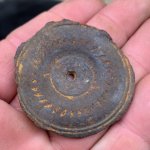calgeologist
Jr. Member
I have a place that i have been checking out all winter that is the drainage of a hydraulic mine. There is only one drain for the tailings and i know a sluice spilled into the drain during operation.
My question is how much gold went through there sluices? Im not looking for a actual number, but would you think it would be enough to explore the area?
Part of me thinks that there must have been a good amount that slipped through and ended up in the tailings. This might just be me hoping for something that doesn't exist
Only problem is that it is extremely difficult to access and its a bid too steep and slick to attempt to check it out during the wet season.
Thanks for the responses
My question is how much gold went through there sluices? Im not looking for a actual number, but would you think it would be enough to explore the area?
Part of me thinks that there must have been a good amount that slipped through and ended up in the tailings. This might just be me hoping for something that doesn't exist
Only problem is that it is extremely difficult to access and its a bid too steep and slick to attempt to check it out during the wet season.
Thanks for the responses
Amazon Forum Fav 👍
Upvote
0


 Educate and prosper as thats what winter is for. Every state has a geo/mines dept with the exact info you seek. Size,shape,configuration utilized,results from yardage,depth to bedrock,kt of gold etc etc-example of what ya need-A SHAKER WITH A 2" SCREEN WAS USED FOR CLASSIFICATION=all nuggets bigger than 2" went BACK into creek or same such info. Read and prosper,sorry gotta run as busy as LL today-John
Educate and prosper as thats what winter is for. Every state has a geo/mines dept with the exact info you seek. Size,shape,configuration utilized,results from yardage,depth to bedrock,kt of gold etc etc-example of what ya need-A SHAKER WITH A 2" SCREEN WAS USED FOR CLASSIFICATION=all nuggets bigger than 2" went BACK into creek or same such info. Read and prosper,sorry gotta run as busy as LL today-John

